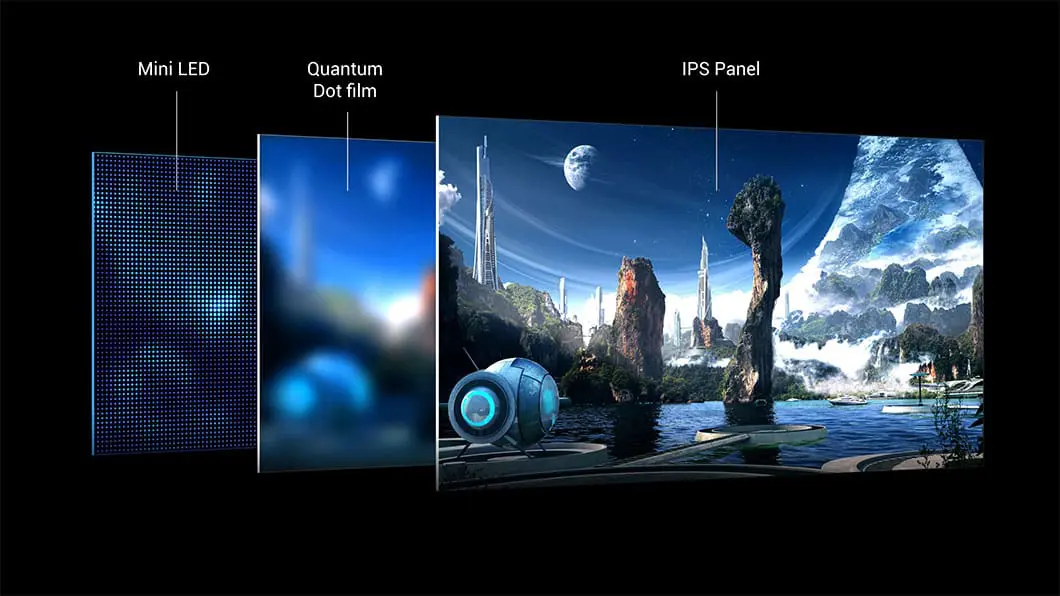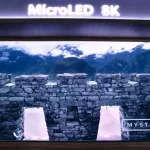
יישומים של צג LED MIP
1. מדוע צגי LED מיני שולטים בשוק
צגי LED מיני מגדירים מחדש מצוינות ויזואלית עם 5,000+ אזורי עמעום מקומי ו בהירות שיא של 4,000 ניטים, מסירה ניגודיות גבוהה יותר של 300% מאשר נורות LED קונבנציונליות (דו"ח שרשרת האספקה לתצוגה 2024). ככל שהצרכנים דורשים חוויות HDR אמיתיות, טכנולוגיה זו הפכה לסטנדרט הזהב עבור טלוויזיות פרימיום, צגים מקצועיים וצגים לרכב.
2. חידושים טכניים לשנת 2025
2.1 ייצור שבבים בקנה מידה זעיר
- שבבי LED של 30 מיקרוןתהליך GaN-on-SiC 2025 של סמסונג מאפשר דיודות קטנות יותר מסוג 40%
- תפוקת העברה של 99.999%העברת מסה בסיוע לייזר של K&S ב 10 מיליון יחידות/שעה
- היברידי נקודות קוונטיותכיסוי 98% DCI-P3 עם אורך חיים של 20,000 שעות
2.2 מערכות נהיגה מתקדמות
- בקרת PWM של 48 סיביותשבב HD8201 של HiSilicon מאפשר רמת שחור של 0.0001 ניטים
- לוחות אחוריים של מטריצת אקטיבית (AM)פאנל 8K 85 אינץ' של BOE עם זמן תגובה של 5ms
- אלגוריתמי עמעום של בינה מלאכותיתניתוח סצנות בזמן אמת באמצעות TensorFlow Lite
3. מדדי ביצועים
| פָּרָמֶטֶר | OLED | 2025 מיני לד | יִתרוֹן |
|---|---|---|---|
| בהירות שיא | 1,000 ניטים | 4,500 ניטים | בהיר יותר פי 4.5 |
| יחס ניגודיות | 1,000,000:1 | 5,000,000:1 | שיפור של פי 5 |
| צריכת חשמל | 180W (טלוויזיה 65 אינץ') | 95W | הפחתת 47% |
4. יישומים מתקדמים
4.1 בידור ביתי
- BRAVIA Z9K של סוני 2025: 10,000 אזורי עמעום + שכבת זווית רחבה במיוחד
- טלוויזיית גיימינג 144Hz של TCL: תמיכה ב-VRR דרך MediaTek Pentonic 2000
4.2 צגי רכב
- מרצדס EQS 2025: מסך היפר מעוגל בגודל 48.8 אינץ' עִם מצב אור יום של 3,000 ניטים
- ניהול תרמי דינמי: ΔT <2°C מתחת לטמפרטורת סביבה של 50 מעלות צלזיוס
4.3 מכשירי מציאות רבודה/מציאות מדומה
- אפל ויז'ן פרו 2: מיקרו-צגי LED מיני כפולים ברזולוציית 8K (7,000 פיקסלים ל-PPI)
- תגובת פיקסלים של 0.1msביטול טשטוש תנועה ב-Meta Quest 4
5. פריצות דרך בייצור
5.1 ייצור חסכוני
- קנה מידה של פרוסות 12 אינץ'האינטגרציה ההטרוגנית התלת-ממדית של TSMC חוסכת עלויות ב-60%
- ליתוגרפיה ננו-אימפרינטקנון FPA-1200 NZ7 מפחית את שלבי הליטוגרפיה ב-50%
5.2 שיפורי עמידות
- זרחנים בעלי ריפוי עצמיהחומר, הממתין לרישום פטנט, של Dow Chemical מפחית את שריפת החומר.
- גלאס קורנינג גורילה LXקשיות 9H עבור פאנלים עמידים בפני שריטות לרכב
6. התגברות על אתגרי התעשייה
6.1 פיזור חום
- מפזרי חום גרפןמוליכות תרמית של 15W/mK (פנסוניק)
- חומרים בעלי שינוי פאזהטכנולוגיית הננו-קפסולות של 3M סופגת 40 ג'אול/גרם
6.2 סטנדרטיזציה
- הסמכת VESA HDR2500קביעת ספי 2,500 ניטים/0.005 ניטים
- תאימות MIPI DSI-2ממשק מאוחד עבור השהיה של פחות מ-2ms
7. מפת דרכים עתידית: מעבר לשנת 2025
7.1 התכנסות מיקרו-לד
- פאנלים היברידיים מיני/מיקרו-לדשילוב שבבים <10μm עם כלכלת Mini LED
- טכנולוגיית ריצוף חלקהLG ללא מסגרת לקירות וידאו בגודל 200 אינץ'
7.2 חידושים ידידותיים לסביבה
- מודולי LED ניתנים למחזורמפת הדרכים לעיצוב מעגלי של סמסונג
- קדמיום 0%זרחנים אדומים ידידותיים לסביבה של EPISTAR










-e1632597207641-150x150.jpg.webp)


